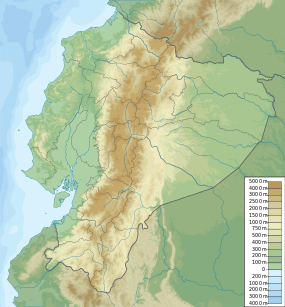1797 Riobamba earthquake
| Date | 4 February 1797 |
|---|---|
| Magnitude | 8.3 Magnitude ML |
| Epicenter | 1°36′S 78°36′W / 1.6°S 78.6°WCoordinates: 1°36′S 78°36′W / 1.6°S 78.6°W |
| Areas affected | Ecuador |
| Casualties | 6,000-40,000 |
The 1797 Riobamba earthquake occurred at 12:30 UTC on 4 February. It devastated the city of Riobamba and many other cities in the Interandean valley, causing up to 40,000 casualties. It is estimated that seismic intensities in the epicentral area reached at least XI (Extreme) on the Mercalli intensity scale, and that the earthquake had a magnitude of 8.3,[1] the most powerful historical event known in Ecuador.[2] The earthquake was studied by Alexander von Humboldt, when he visited the area in 1801/2.[3]
Tectonic setting
The active tectonics of Ecuador is dominated by the effects of the subduction of the Nazca Plate beneath the South American Plate. The main NNE-SSW trending fault systems show a mixture of dextral (right lateral) strike-slip faulting and reverse faulting. In addition to these faults that run parallel to the Andes in Ecuador, there are two important SW-NE trending-dextral-fault systems: the Pallatanga fault and the Chingual fault.[4] The Pallatanga fault runs close to the epicenter and movement on this fault has been suggested as the cause of the earthquake, although there is no clear surface break supporting such recent movement.[5]
Damage
The area of significant damage (Intensity ≥VII) extended from Quito in the north to more than 60 km south of Riobamba, including the cities of Guaranda, Ambato, Latacunga and the towns of Saquisilí and Baños.[5] Riobamba and the town of Quero were both destroyed by landslides. At the foot of the Tungurahua volcano, the Pastaza River was dammed by landslides for up to eighty days.[6]
Humboldt's analysis of this earthquake relied on anecdotal accounts that he gathered during his visit. Some of the observations such as "the bodies of many of the inhabitants were found to have been hurled to Cullca, a hill several hundred feet in height and on the opposite side of the river Lican", are not credible.[7] He gave a figure of thirty to forty thousand for the number of casualties, while some more recent estimates give figures as low as six thousand.[8]
Characteristics
The shaking lasted for three to four minutes.[9] The estimated rupture length for the earthquake is 70.3 km, with a fault azimuth of 067°.[10]
Aftermath
The city of Riobamba was rebuilt nearly 20 km northeast of its original site, now occupied by the small town of Cajabamba.[11]
See also
-
 Ecuador portal
Ecuador portal - List of earthquakes in Ecuador
- List of historical earthquakes
References
- ↑ NGDC. "Comments for the Significant Earthquake". Retrieved 20 August 2010.
- ↑ Chunga, K. "Seismic Hazard Assessment for Guayaquil City (Ecuador): Insights from Quaternary Geological Data" (PDF). Retrieved 22 August 2010.
- ↑ Lavilla, E.O. (2004). "Under the Southern Cross: Stories around Humboldt and Bonpland's trip to the New Continent" (PDF). Latin American Applied Research. 34: 203–208. Retrieved 22 August 2010.
- ↑ Eguez, A.; Alvarado A.; Yepes H.; Machette M.N.; Costa C. & Dart R.L. "Database and Map of Quaternary faults and folds of Ecuador and its offshore regions" (PDF). USGS Open-File Report 03-289. pp. 2–3. Retrieved 22 August 2010.
- 1 2 Winter, T.; Avouac J-P. & Lavenu A. (1993). "Late Quaternary kinematics of the Pallatanga strike-slip fault (Central Ecuador) from topographic measurements of displaced morphological features" (PDF). Geophysical Journal International. 115: 905–920. Bibcode:1993GeoJI.115..905W. doi:10.1111/j.1365-246X.1993.tb01500.x. Retrieved 22 August 2010.
- ↑ Lyell, Charles (1830). "XXIII". Principles of Geology (PDF) (1st ed.). John Murray. p. 410. Retrieved 22 August 2010.
- ↑ Wood, H.O. (1911). "The observation of earthquakes: A guide for the general observer". Bulletin Seismological Society of America. 1 (2): 65–67. Retrieved 22 August 2010.
- ↑ IISEE (25 December 2008). "Catalog of Damaging Earthquakes in the World - Search parameters". Archived from the original on 21 July 2010. Retrieved 22 August 2010.
- ↑ Amodio, E. (2005). "Las furias del temblor. Análisis comparativo de dos sismos históricos: Quito, febrero 1797 y Cumaná, diciembre 1797" (PDF). Revista Geográfica Venezolana (in Spanish): 119–141. Retrieved 20 August 2010.
- ↑ Giesecke, A.; Capera A.A.G.; Leschiutta I.; Migliorini E. & Valverde L.R. (2004). "The CERESIS earthquake catalogue and database of the Andean Region: background, characteristics and examples of use" (PDF). Annals of Geophysics. 47 (2/3): 421–435. Retrieved 22 August 2010.
- ↑ Kunstaetter, R.; Kunstaetter, D. (2007). Footprint Ecuador and Galápagos (6th ed.). Footprint Travel Guides. p. 244. ISBN 978-1-904777-93-9. Retrieved 20 August 2010.

